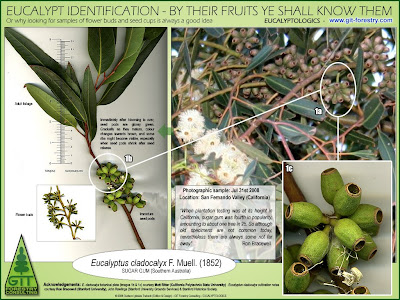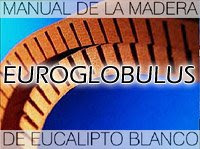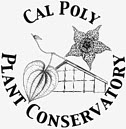Share
Eucalypt plantations only successful as pulpwood tree farms? Bullshit!
The Australian Government statutory corporation RIRDC (Rural Industries Research and Development Corporation) has just released a new publication on Eucalyptus timber production that should be of interest for public and private investors in all those areas of the world where the Australian trees have become an important forestry resource.  Plantation Eucalypts for High-Value Timber: Enhancing investment through R+D.Proceedings of the Plantation Eucalypts for High Value Timber 2007 Conference, Melbourne, Australia.
Plantation Eucalypts for High-Value Timber: Enhancing investment through R+D.Proceedings of the Plantation Eucalypts for High Value Timber 2007 Conference, Melbourne, Australia.
(Download, 8 Mb PDF)
 Fig 1: Eucalyptus polyculture: pasture plus pruned and thinned trees producing high value logs following a multi-product agroforestry management regime. (Click image to enlarge)
Fig 1: Eucalyptus polyculture: pasture plus pruned and thinned trees producing high value logs following a multi-product agroforestry management regime. (Click image to enlarge)Innovative farmers and forestry enterprises down under in Australia and New Zealand have been consistently proving for a time that eucalypts, these highly diverse trees by number of species, growth habits, yield of products or externalities, are also a source of diversity in what to sustainable forestry management and tree farms and their products refers.
 Fig. 2: Jon Lambert's forestry investment advisor firm Woollybutt Pty Ltd is one of the main promoters of sustainable High Value Eucalyptus timber productive plantations among farmers in Victoria. Here we see them inspecting a Corymbia maculata hardwood eucalypt plantation for high value timber log production, also managed for simultaneous pasture production. (Click image to enlarge)
Fig. 2: Jon Lambert's forestry investment advisor firm Woollybutt Pty Ltd is one of the main promoters of sustainable High Value Eucalyptus timber productive plantations among farmers in Victoria. Here we see them inspecting a Corymbia maculata hardwood eucalypt plantation for high value timber log production, also managed for simultaneous pasture production. (Click image to enlarge)Currently, examples of Eucalyptus plantations managed under mixed timber production management plans (aiming for instance to a combination of pulpwood plus solid wood) spread through countries in four continents, in many cases contributing to the diversification of timber productive units within technified farms following agroforestry principles. When properly designed and implemented, they can become a very clever and successful way to integrate tree farming in overal farming schemes, and it is especially in these cases when the concepts of polyculture, sustainable forestry, multiple production, high quality and value timber, silvopastoralism, farm forestry and organic farming become directly involved with Eucalyptus. As with many other types of trees.
The Australian and some of the New Zealander state of the art experience in this wonderful type of Eucalyptus tree farming has been put together at the Plantation Eucalypts for High Value Timber 2007 Conference, where experts from industry, academic research, governmental agencies, forestry management companies and farm forestry investors offered their latest findings, which have now taken the form of these proceedings.Speakers include well renowned international and national experts as Vince Erasmus (ITC Forestry Ltd), Clinton Tepper (Woollybutt Pty Ltd), Peter Volker (Forestry Tasmania, CRC for Forestry), David Quill (Eumeralla Pty Ltd), Russell Washusen (CSIRO-Ensis), Tony Cannon (Forest Enterprises Australia Pty Ltd), Trevor Innes (FEA Timber Pty Ltd), Martin Grealy (Forests NSW), David Bush (CSIRO-Ensis), Craig Taylor (The Fifth Estate Consultancy Pty Ltd), and Rodney Keenan (The University of Melbourne).We wish you a happy reading!! Plantation Eucalypts for High Value Timber Conference was sponsored by...

Also in Eucalyptologics...


Pulpwood... but
Not just pulpwood!

Want to contact us?
 Contact GIT Forestry Consulting - Eucalyptologics
Contact GIT Forestry Consulting - Eucalyptologics
 GIT's Eucalyptology Topics
GIT's Eucalyptology Topics Subscribe to receive EUCALYPTOLOGICS via RSS
Subscribe to receive EUCALYPTOLOGICS via RSS
Click to Read Full Story...
Click to Display Summary only...
Share
Spinning Gum: cold hardy Eucalyptus from Alpine Australia (II)Notes on phenology and cultivation in cold temperate climatesGustavo Iglesias Trabado  GIT Forestry Consulting - Consultoría y Servicios de Ingeniería Agroforestal - www.git-forestry.com - EUCALYPTOLOGICS
GIT Forestry Consulting - Consultoría y Servicios de Ingeniería Agroforestal - www.git-forestry.com - EUCALYPTOLOGICS A few weeks ago, the Spinning Gums started blooming in Galicia. After the initial stages, when a small number of flower bud clusters reach anthesis randomly, the peak flowering season was reached by late July, causing havoc among local bees.  Fig. 1: Peak of flower blooming season in a Spinning Gum (E. perriniana) growing in Galicia (NW Spain). Juvenile & intermediate foliage are present during the first flowering seasons. (Click image to enlarge)
Fig. 1: Peak of flower blooming season in a Spinning Gum (E. perriniana) growing in Galicia (NW Spain). Juvenile & intermediate foliage are present during the first flowering seasons. (Click image to enlarge)GIT Forestry Consulting & Eucalyptologics are proud to report that after a shy first flowering season, the second season after reaching reproductive maturity has allowed this Eucalyptus to bloom freely and profusely, while new flower buds keep developing for further flowering in the next years. Reproductive cycle will be complete in some months, so this cold hardy eucalypt species can be considered fully viable and well acclimatised for our local conditions.
The pictured tree is the first of its kind successfully grown and acclimatised in Galicia (Northwestern Spain). And hopefully, the first of many to grow in the near future. For a description of the climatic types well endured by this species, just check our previous post "Spinning Gum, cold hardy Eucalyptus from Alpine Australia. Notes on phenology and cultivation in cold temperate climates".
Phenologic notes on E. perriniana in Galicia
- Flower bud initiation: May/June (late spring, early summer)
- Flower bud maturity: +10 /+12 months (late spring, summer)
- Flowering period: May/August (summer, peak in July)
- Seed pod maturity: +20 /+25 months since flower bud initiation
- Simultaneous reproductive cycles: 1 cycle of immature flower buds + 1 cycle of seed pods in maturation + 1 cycle of ripe or senescent seed pods can be present at once in the same specimen
Spinning Gum, another Eucalyptus acclimatised to Scandinavia
 Fig. 3: Peak of flower blooming season in a Spinning Gum (E. perriniana) growing in Denmark. Juvenile & intermediate foliage are present during the first flowering seasons. (Click image to enlarge)
Fig. 3: Peak of flower blooming season in a Spinning Gum (E. perriniana) growing in Denmark. Juvenile & intermediate foliage are present during the first flowering seasons. (Click image to enlarge)Our good friend Frank Diron at Eucalyptus Haven (www.eucalyptushaven.dk) reports similar success and acclimatisation for the specimens of Spinning Gum growing at latitude 55ºN (roughly the same as Moscow!) in his Eucalyptus collection at Fanø Island in Denmark. 
Contact us / Subscribe to Eucalyptologics
 Contact GIT Forestry Consulting - Eucalyptologics
Contact GIT Forestry Consulting - Eucalyptologics
 GIT's Eucalyptology Topics
GIT's Eucalyptology Topics Subscribe to receive EUCALYPTOLOGICS via RSS
Subscribe to receive EUCALYPTOLOGICS via RSS
Click to Read Full Story...
Click to Display Summary only...
Share
By their fruits ye shall know them (IV)
Yet more tips on Eucalyptus Identification
Gustavo Iglesias Trabado  GIT Forestry Consulting - Consultoría y Servicios de Ingeniería Agroforestal - www.git-forestry.com
GIT Forestry Consulting - Consultoría y Servicios de Ingeniería Agroforestal - www.git-forestry.com
We have previously seen in EUCALYPTOLOGICS how bark features alone can be misleading for accurate Eucalyptus species identification, showing examples of different bark types for the same eucalypt species and of similar bark types for different eucalypt species. We have also seen how in some cases just a small sample of flower buds can yield an accurate identification. Today we will see how just a distant photograph of seed cups (fruits) can yield a very promising species identification. Fig. 1: Example of fruit based diagnosis useful for accurate Eucalyptus species identification (Click image to enlarge)
Fig. 1: Example of fruit based diagnosis useful for accurate Eucalyptus species identification (Click image to enlarge)
Our good friend Phil at Eucs-In-Habitat reported a mystery Eucalyptus growing in San Fernando Valley. Drew, the local observer in California, followed our recommended sequential observation process for eucalypt identification and took photographs of the overall outlook of the tree, its bark and of reproductive organs (blooming flowers, but more importantly, seed cups, the fruits).
 Fig 3: Blooming Eucalyptus cladocalyx in California. Image courtesy of Drew_2008. (Click image to enlarge)
Fig 3: Blooming Eucalyptus cladocalyx in California. Image courtesy of Drew_2008. (Click image to enlarge)
These fruit samples, even if just photographed using a zoom, are what allows a very good bet as botanical identification of this Eucalyptus tree (see Fig. 1) by comparison to a botanical plate prepared with locally collected samples. And the solution was Eucalyptus cladocalyx, also known by its vernacular name Sugar Gum.
In addition, once again a look back in time paying attention to previous eucalypt experts can yield complementary data to support or reject an attempt of Eucalyptus species identification. "
When Eucalyptus plantation testing was at its height in California, sugar gum was fourth in popularity, amounting to about one tree in 25. So although old specimens are not common today, nevertheless there are always some not far away. (...) The tall smooth boles are free from lower branches and are in many cases recognizable on sight by warm-colored bark, with long vertical fissures and horizontal rows of dimples left over from insect bites years ago. On the ground you can pick up distinctive barrel-shaped fruit in clusters of up to 15 in number; these clusters in themselves suffice to give you confidence that you are under a sugar gum the next time you see them among the ground litter."
Eucalyptus species identification for this tree as E. cladocalyx makes sense then both in botanical but also in geographic and historical contexts. No doubt, once again we can see Eucalyptology is an interdisciplinary science.
Acknowledgements

Click to Read Full Story...
Click to Display Summary only...
 Coordenação e Redação Técnica - Ester Foelkel & Celso Foelkel
Coordenação e Redação Técnica - Ester Foelkel & Celso Foelkel




























































